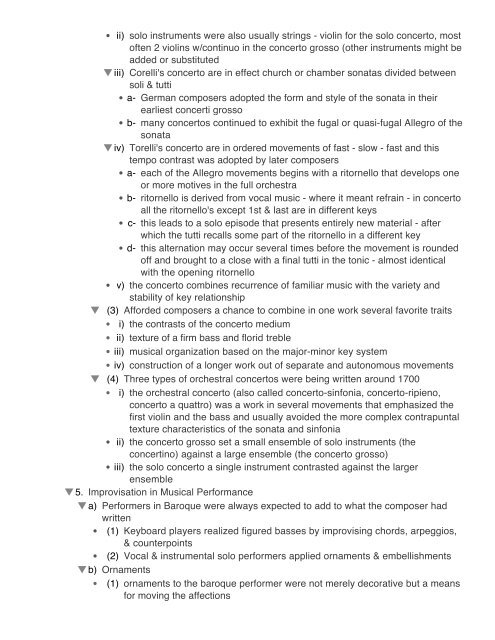An Outline of The History of Western Music Grout ... - The Reel Score
An Outline of The History of Western Music Grout ... - The Reel Score
An Outline of The History of Western Music Grout ... - The Reel Score
Create successful ePaper yourself
Turn your PDF publications into a flip-book with our unique Google optimized e-Paper software.
ii) solo instruments were also usually strings - violin for the solo concerto, most<br />
<strong>of</strong>ten 2 violins w/continuo in the concerto grosso (other instruments might be<br />
added or substituted<br />
iii) Corelli's concerto are in effect church or chamber sonatas divided between<br />
soli & tutti<br />
a- German composers adopted the form and style <strong>of</strong> the sonata in their<br />
earliest concerti grosso<br />
b- many concertos continued to exhibit the fugal or quasi-fugal Allegro <strong>of</strong> the<br />
sonata<br />
iv) Torelli's concerto are in ordered movements <strong>of</strong> fast - slow - fast and this<br />
tempo contrast was adopted by later composers<br />
a- each <strong>of</strong> the Allegro movements begins with a ritornello that develops one<br />
or more motives in the full orchestra<br />
b- ritornello is derived from vocal music - where it meant refrain - in concerto<br />
all the ritornello's except 1st & last are in different keys<br />
c- this leads to a solo episode that presents entirely new material - after<br />
which the tutti recalls some part <strong>of</strong> the ritornello in a different key<br />
d- this alternation may occur several times before the movement is rounded<br />
<strong>of</strong>f and brought to a close with a final tutti in the tonic - almost identical<br />
with the opening ritornello<br />
v) the concerto combines recurrence <strong>of</strong> familiar music with the variety and<br />
stability <strong>of</strong> key relationship<br />
(3) Afforded composers a chance to combine in one work several favorite traits<br />
i) the contrasts <strong>of</strong> the concerto medium<br />
ii) texture <strong>of</strong> a firm bass and florid treble<br />
iii) musical organization based on the major-minor key system<br />
iv) construction <strong>of</strong> a longer work out <strong>of</strong> separate and autonomous movements<br />
(4) Three types <strong>of</strong> orchestral concertos were being written around 1700<br />
i) the orchestral concerto (also called concerto-sinfonia, concerto-ripieno,<br />
concerto a quattro) was a work in several movements that emphasized the<br />
first violin and the bass and usually avoided the more complex contrapuntal<br />
texture characteristics <strong>of</strong> the sonata and sinfonia<br />
ii) the concerto grosso set a small ensemble <strong>of</strong> solo instruments (the<br />
concertino) against a large ensemble (the concerto grosso)<br />
iii) the solo concerto a single instrument contrasted against the larger<br />
ensemble<br />
5. Improvisation in <strong>Music</strong>al Performance<br />
a) Performers in Baroque were always expected to add to what the composer had<br />
written<br />
(1) Keyboard players realized figured basses by improvising chords, arpeggios,<br />
& counterpoints<br />
(2) Vocal & instrumental solo performers applied ornaments & embellishments<br />
b) Ornaments<br />
(1) ornaments to the baroque performer were not merely decorative but a means<br />
for moving the affections<br />
(2) also the more common ornaments added a spice <strong>of</strong> dissonance that the<br />
notated music lacked





